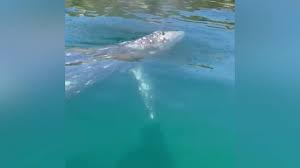Gray whale sighted in front of Naples: born in the Atlantic, where it was extinct?
NAPLES – A whale believed to be extinct in the Atlantic has been sighted in the Mediterranean, along the Italian coast, to be precise between the Gulf of Naples and Ponza, and is said to be continuing its ‘journey’ northwards.
It is a specimen of a gray whale whose only two sightings known so far, one in the Mediterranean in front of Israel and one in front of Namibia on the Atlantic, were attributed to animals probably coming from the Pacific through an ice-free passage in the Arctic. Instead, for the gray whale sighted in these days things could be different: its appearance, according to the experts of the Tethys Onlus Institute (non-profit organization for the study and protection of the marine environment: http://www.tethys.org), could perhaps be the sign of a return of the species to the ocean from which it disappeared.
The gray whale (Eschrichtius robustus) is found today only in the North Pacific, and is one of the largest naturalistic attractions in the lagoon of Baja California, Mexico. In the Atlantic, however, it was completely exterminated by whaling, so much so that it disappeared in the eighteenth century. These days is the first sighting in Italian waters; the only other in the Mediterranean dates back to May 2010 off the coast of Israel and, a few weeks later, near Barcelona. Only one animal has so far been documented in the Atlantic: it was in 2013, near the coast of Namibia, and it was a different individual from that of three years earlier.
As for the ‘Italian’ gray whale, “it is a different individual both from that of 10 years ago and from that of Namibia”, confirms Sabina Airoldi of the Tethys Institute for the study and protection of cetaceans, through the technique of photo identification. After all, it would not have been possible, because it is a smaller individual: the estimates made at sea by biologists and Coast Guard personnel are around 7/8 meters. “If they are correct, since an exact measurement cannot be made at sea, it would mean that it is a young man of about 6-7 months, so at best just weaned” explains Maddalena Jahoda of the Tethys Institute. “In the Pacific, the chicks are born in the winter, in the south and are now migrating, in the spring, to Alaska where they will spend the summer eating. A baby this winter would not have had time to reach us by crossing the pole. Hence the hypothesis, and I stress that for now it is only a hypothesis yet to be verified, that it may have been born in the Atlantic, perhaps a sign of a timid return by this species.
If instead it were bigger, about 9 meters, it could be at least a year old, and actually come from the Pacific “.
This last path, through the arctic waters, was hypothesized to explain the appearance of the two previous whales in the “wrong” ocean, in a scientific publication by Aviad Scheinin, of the IMMRAC (Israel Marine Mammal Research and Assistance Center) which had studied the Israeli case. The polar waters, now increasingly free of ice due to climate change, could allow animals to pass from the Pacific to the Atlantic.
The gray whale of these days, first sighted in Ponza, then in Sorrento and finally in the port of Baia, is certainly always the same, as the researchers of Tethys have established by comparing the pigmentation on photos and videos. “What we now ask ourselves – says Maddalena Jahoda – is whether a young and inexperienced gray whale, which would seem rather thin, can find the suitable food in the Mediterranean that it is in dire need of this season”. In fact, gray whales have another peculiarity: they usually do not filter plankton from the water, such as fin whales in the Mediterranean, but sift small crustaceans and other animals from the mud on the seabed. “There is a worrying precedent in the Pacific – adds Sabina Airoldi -: in 2019 and 2020 there was a death of gray whales, which appeared thin and emaciated, and the same had already happened around 2000. The hypothesis is that a periods, especially recently, the animals do not find sufficient food precisely because of the profound climatic changes in the polar waters. “
However things may be, the hope is only one: that the cetacean will find its way home, whatever it is.
(the video was kindly made available by Giacomo Lembo)



